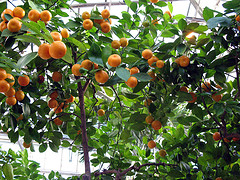Difference between revisions of "Oranges"
From Cargo Handbook - the world's largest cargo transport guidelines website
| Line 1: | Line 1: | ||
{{Infobox_Fruit | {{Infobox_Fruit | ||
| image = oranges.jpg | | image = oranges.jpg | ||
| − | | carrying temperature = 2°C to 7°C (dependent upon cultivar/origin)<br> Some examples: <br> Navel : Moroccan, Spanish, 2°C to 3°C <br> Salustiana : Spanish, 2°C <br> Valencia Late : Moroccan, Cyprus, 2°C to 3°C <br> Spanish, 2°C <br> South African, 4,5°C <br> USA (California), 2°C to 7°C | + | | carrying temperature = 2°C to 7°C (dependent upon cultivar/origin)<br> Some examples: <br> <u>Navel</u>: <br> Moroccan, Spanish, 2°C to 3°C <br> <u>Salustiana</u>: <br> Spanish, 2°C <br> <u>Valencia Late</u>: <br> Moroccan, Cyprus, 2°C to 3°C <br> Spanish, 2°C <br> South African, 4,5°C <br> USA (California), 2°C to 7°C |
| highest freezing point = | | highest freezing point = | ||
| acceptable product temp = | | acceptable product temp = | ||
Revision as of 13:29, 10 March 2011
| Infobox on Oranges | |
|---|---|
| Example of Oranges |  |
| Freshness facts | |
| Optimum carrying temperature | 2°C to 7°C (dependent upon cultivar/origin) Some examples: Navel: Moroccan, Spanish, 2°C to 3°C Salustiana: Spanish, 2°C Valencia Late: Moroccan, Cyprus, 2°C to 3°C Spanish, 2°C South African, 4,5°C USA (California), 2°C to 7°C |
| Highest freezing point | |
| Acceptable product temp. at loading into containers | |
| Optimum humidity | |
| Ventilation setting for containers | |
| Storage life | |
| Climacteric / non-climacteric | |
| Ethylene production | |
| Ethylene sensitivity | |
| Modified / controlled atmosphere | |
| Potential benefits | |
| Availability | |











